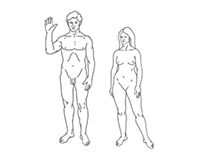iConji is a free pictographic communication system based on an open, visual vocabulary of characters with built-in translations for most major languages. The app debuted with 1183 unique characters, known as the lexiConji (vocabulary), culled from base words used in common daily communications, word frequency lists, often-used mathematical and logical symbols, punctuation symbols, and the flags of all nations.
The process of assembling a message from iConji characters is called iConjisation. Since most characters represent an entire word or concept, rather than a single letter or character, iConji has the potential to be a more efficient communication system than SMS (texting). The usual jumble of text and confusing abbreviations can often be replaced by a short string of colorful icons that convey the identical meaning.
The characters themselves are evocative of their meanings, and designed to be as cross-cultural as possible. Of course, pictographic symbols can never be truly universal. For example, extensive research went into the design of warning signs for the nuclear waste repository planned at Yucca Mountain, Nevada, focusing on what would be comprehensible and unambiguous ‘danger’ symbols to all readers 10,000 years hence. Further, not all cultures read symbols or text from left to right, which is the standard for iConji. In addition, some linguistic concepts are too abstract to represent graphically.
Unique to iConji is its inclusion of both an inferred meaning, suggested by the pictographs themselves, and the translations that accompany each character. These translations include Chinese, English, French, German, Hindi, Italian, Japanese, Polish, Spanish, and Swahili. Esperanto and Thai are works in progress. The iConji vocabulary is open to revision — anyone in the world may design and contribute new characters for use in global communications. Through the Artist Community, users are able to add their own characters to the lexiConji (with approval), or revise existing character icons they feel could be better represented graphically.
There has been no shortage of attempts to create a new and ‘better’ universal language. According to linguist Arika Okrent, in the last thousand years, more than 900 languages have been invented, often by individuals who believed they had a universal solution for global, cross-cultural communication. About a dozen of these are based on pictographs. Most attempts at creating a new language failed due to overly-ambitious goals, or eccentricities of their inventor.
Of all the recently invented pictographic systems, Blissymbolics is the most successful to date. It is used to assist communications-challenged individuals, providing them a structured means by which they may convey concepts, and more recently, providing a ‘point and click’ software interface. The Noun Project is another effort to establish cross-cultural communication. It purports to be a repository of universal icons, but suffers the same ambiguities as previous ‘universal language’ attempts. The icons therein are primarily from public-domain icon databases, for example, restroom, traffic, mall, and airport icons, not all of which translate across cultures. Also of note is Emoji, based on a vocabulary of 722 emoticons, and popular in electronic communications throughout Japan. Emoji icons are heavily slanted toward conveying emotional ‘punctuation,’ and more useful in augmenting SMS than in communicating complete stand-alone messages.
The Daily Omnivore
Everything is Interesting



Leave a comment